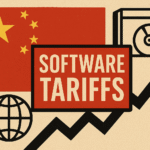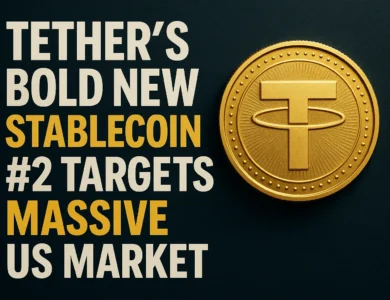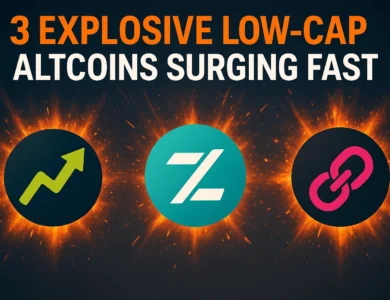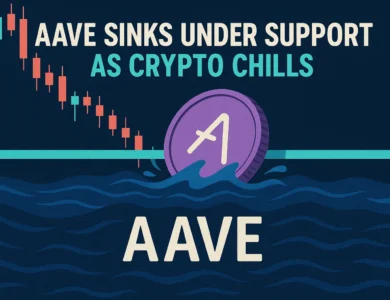
The Bitcoin price tumbled toward the $108,000 mark after U.S. President Donald Trump announced he would impose an additional 100% tariff on Chinese imports starting in November, sharply escalating the U.S.–China trade war. Crypto and equity markets reeled as investors priced in a new phase of geopolitical tension and macro headwinds, sending risk assets lower across the board.
Several major outlets reported that Bitcoin traded through the high-$100Ks and low-$100Ks intraday, with one widely cited spot snapshot showing BTC near $104,000–$110,000 during the immediate sell-off window. Traditional indexes also fell as traders rushed to reassess growth, inflation, and supply chain scenarios in light of sweeping trade restrictions and fresh export controls on critical U.S. software.
Below, we break down what happened, why the “tariff shock” mattered so much to crypto, how cross-asset flows amplified the drop, and the key levels and catalysts that could define the next leg of Bitcoin’s trajectory.
What exactly did the White House announce?
On October 10, 2025, President Trump said the U.S. will slap an additional 100% tariff on Chinese imports starting November 1, on top of pre-existing duties. In the same breath, he signaled stringent export controls on critical software, underscoring a comprehensive hardening of U.S. trade policy toward Beijing. The administration framed the move as a response to China’s newly expanded rare-earth export restrictions, which the White House argues threaten U.S. technology and defense supply chains. Markets also digested the possibility of canceling an upcoming U.S.–China leader-level meeting, injecting further uncertainty into diplomatic channels.
How markets reacted in real time
In the hours that followed, Bitcoin slid markedly, trading down into the $104,000–$110,000 zone at the trough of the move. Major risk barometers also flashed red: U.S. equities saw one of their sharpest down days since spring, with the S&P 500 and Dow both suffering outsized declines as investors rotated defensively. Ethereum and large-cap altcoins followed BTC lower, reflecting broad risk-off flows. Financial media linked the equity slump and crypto sell-off to tariff escalation, fears of retaliatory measures, prolonged supply bottlenecks, and higher pass-through costs that could reignite inflation.
Why would tariffs hit the Bitcoin price?
Tariffs, growth, and liquidity
Tariffs are, in essence, a tax on trade. When the world’s largest economy raises import costs dramatically, markets start modeling slower global growth, profit margin compression, and stickier inflation. Slower growth with persistent price pressures can force central banks to keep financial conditions tight, or at least not ease as fast as risk assets would like. Because Bitcoin trades as a high-beta macro asset during stress events, tighter liquidity and higher real yields can weigh on the Bitcoin price, particularly when the shock is sudden and policy-driven rather than gradual.
Supply chains, chips, and the tech complex
Crypto doesn’t operate in a vacuum. The digital asset ecosystem sits upstream and downstream from the same semiconductor and cloud infrastructure that powers Web3, exchanges, mining, and custody. If tariffs and export controls squeeze hardware availability or raise costs, markets extrapolate pain for miners, custody providers, and high-growth tech firms. Equity carnage in mega-cap tech can spill over into crypto risk appetite, pressuring the Bitcoin price as systematic strategies de-risk.
Was $108,000 a “crash” or a reset? Context matters
Only a week earlier, BTC had been flirting with six-figure-plus levels amid strong spot demand and a bullish post-halving narrative. That backdrop made the sudden drop toward approximately $108,000 look dramatic even if, in a broader cycle context, it still sat within a higher-low structure compared to prior months. Importantly, intraday prints showed even deeper lows on some venues, suggesting a swift liquidation cascade before buyers stabilized the tape. Several reports captured intra-day lows near ~$104,000, reflecting how cross-venue volatility can briefly puncture widely watched levels.
The macro chain reaction behind the sell-off

1) Positioning and leverage
The run-up to October had invited leverage back into the market via perpetual futures and margin-financed spot. When the tariff headline hit, funding markets repriced quickly, leading to long liquidations that intensified the move. In these episodes, “air pockets” form as bids thin out, forcing steeper declines until basis and funding normalize.
2) Dollar strength and real yields
Trade war headlines tend to boost the U.S. dollar—a headwind for dollar-denominated assets like Bitcoin. Simultaneously, a stagflationary narrative can nudge real yields higher, raising the opportunity cost of holding non-yielding risk assets if the Treasury curve backs up. At the same time, the dollar rallies, crypto’s immediate-term beta can skew negative.
3) Equity correlation
During policy shocks, the Bitcoin price often correlates positively with the Nasdaq and S&P 500. Equity drawdowns catalyze de-risking across portfolios, pushing crypto lower even if long-run theses remain intact. That’s precisely what broad tape action suggested after the tariff announcement, with reporters noting one of the worst single-day sell-offs in months.
What could turn the tide?
Diplomatic off-ramps
Markets will watch for signaling that the U.S. and China are exploring off-ramps—extensions, phased rollouts, carve-outs, or a framework for exemptions. Even a hint of de-escalation can ease risk premiums, allowing the Bitcoin price to rebuild above psychological levels. Conversely, confirmation of a November 1 activation without carve-outs—or rapid retaliation from Beijing—could keep volatility elevated.
Central-bank communication
If tightening financial conditions and weaker risk sentiment spill over into broader credit channels, central banks may push a more data-dependent posture. Any signal that policy will cushion growth risks without reigniting inflation could support a rebound in crypto market breadth.
Structural demand: ETFs, corporates, and sovereigns
Despite knee-jerk risk-off reactions, structural demand has deepened in this cycle. Spot Bitcoin ETFs, corporate treasuries pursuing a Bitcoin standard, and incremental institutional mandates create a sturdier underlying bid. Recent headlines about significant corporate accumulations underscore that balance-sheet adoption hasn’t vanished—even if short-term volatility is fierce. While individual transaction details vary, the bigger picture is that crypto’s on-ramps are broader than in prior cycles.
Key technical zones to watch
Psychological round numbers
The six-figure handle is a magnet for flows. Bulls want to see Bitcoin price sinks reclaim and hold $110,000–$115,000 with conviction. A strong daily close back above those bands would suggest buyers absorbed the tariff shock and that dip-buying interest remains robust.
Prior breakout regions
In late September and early October, BTC’s break above prior resistance in the low-$100Ks turned that area into a potential support shelf. Losing that shelf can invite a retest of the mid-$90Ks, where long-term moving averages and anchored VWAPs cluster in many traders’ models.
Momentum confirmation
Watch for rising spot volumes on up-days, stabilizing funding rates, and narrowing futures basis. Those ingredients, combined with diminishing liquidation footprints, would hint that the “panic phase” has passed.
Bitcoin’s unique place in a tariff world

Hedge or high beta? It can be both.
Critics argue Bitcoin isn’t a pure inflation hedge, citing its correlation with tech equities and its vulnerability to liquidity shocks. Advocates point out that persistent fiat debasement, heavy sovereign debt loads, and de-globalization ultimately bolster the long-run case for hard, programmable money. Both can be true at different timescales. Over days and weeks, liquidity dominates; over years, policy regimes and scarcity narratives rule.
De-globalization as a secular driver
If the U.S. and China entrench into more rigid trade blocs, the world could see structurally higher capex and inventory buffers, punctuated by periodic supply shocks. That backdrop tends to raise the value of censorship-resistant, globally transferable collateral. In short, Bitcoin may be a short-term victim of tariff turbulence yet a long-term beneficiary of the forces that turbulence unleashes.
What to watch between now and November 1
The letter of the policy
Investors should read the fine print: which categories face the 100% rate, how exemptions or waivers are granted, whether enforcement phases in, and how export controls are implemented. The tariff architecture determines the proper growth and inflation impulse that markets must price.
China’s response
Beijing’s counter-measures—particularly on rare-earths, semiconductors, or antitrust actions targeting U.S. tech—will shape the path of least resistance for risk assets. Signals of restraint could set a floor under the Bitcoin price; escalation risks further drawdowns.
Market microstructure
Track order book depth across major exchanges, the distribution of liquidation clusters, and open interest concentration. Thin books and crowded leverage leave prices vulnerable to the following headline. Healthier depth and cleaner positioning would help Bitcoin rebuild.
Investment frameworks for a headline-driven tape
Time-horizon discipline
Short-term traders live and die by event risk; long-term allocators focus on supply issuance, adoption curves, and the stock-to-flow profile of Bitcoin. Knowing your horizon is critical when macro shocks hit. If you’re trading headlines, recognize that liquidity gaps can make stops slip; if you’re allocating for a decade, tariff cycles may fade against digital scarcity and rising institutional rails.
Scenario mapping
Map two simple scenarios. In a de-escalation path, tariffs are delayed or diluted, risk assets recover, and BTC reclaims high-$110Ks to $120K+. In an escalation path, tariffs start on schedule with minimal carve-outs, the dollar firms, and BTC chops between high-$90Ks and low-$110Ks until the policy fog lifts. Markets can toggle rapidly between those states; your sizing and risk controls should adapt accordingly.
Don’t over-optimize narratives.
It’s tempting to force every tick into a single story. But the Bitcoin price reflects a mosaic of factors: macro policy, microstructure, ETF flows, miner dynamics, stablecoin liquidity, and more. Keep an eye on breadth, on-chain activity, and funding rather than leaning solely on any one headline.
Final Thoughts
The overnight tariff shock jolted global markets and sent the Bitcoin price down toward $108,000, with some venues recording deeper intraday lows as forced sellers hit thin order books. The magnitude of the White House’s move—an additional 100% tariff on Chinese imports layered atop existing duties—caught risk assets flat-footed and revived the playbook from prior trade war escalations.
In the future, the interplay between policy details, diplomatic signaling, and liquidity conditions will determine whether this was a sharp shakeout within a strong cycle or the start of a lengthier consolidation. Investors should brace for headline-driven volatility while keeping sight of the longer-term digital gold thesis that underpins Bitcoin’s secular adoption.
FAQs
Q: Did Bitcoin really “crash,” even though $108,000 is still high historically?
Yes—“crash” describes the speed and depth of the drop from recent prices, not the absolute level versus prior years. BTC had been trading well above $110K before the tariff shock, then slid quickly through psychologically important bands toward the $108K area, with some reports capturing intraday prints even closer to $104K. In rapid markets, such a multi-thousand-dollar move is crash-like regardless of the long-term uptrend.
Q: Why do trade tariffs affect crypto if Bitcoin is decentralized?
Decentralization doesn’t shield Bitcoin from macro liquidity. Tariffs can slow growth and keep financial conditions tight, pressuring risk assets. When equities slide and the dollar strengthens, the Bitcoin price often experiences knock-on effects from positioning unwinds and funding pressure.
Q: Could the tariff plan change before November 1?
Yes. The administration indicated implementation could shift depending on China’s actions. Markets will parse any updates, exemptions, or delays as potential relief valves for risk sentiment.
Q: Are there signs this is just a shakeout rather than a trend reversal?
Watch for recovering spot volumes on up-moves, stabilizing funding rates, and resilience around prior breakout levels. If BTC quickly reclaims and holds $110K–$115K, that would argue for a shakeout. Failure there—and renewed policy escalation—would suggest a longer consolidation.
Q: What else could move the Bitcoin price from here?
Beyond tariffs and diplomacy, keep an eye on inflation data, central-bank speeches, ETF inflows/outflows, miner selling, and significant corporate treasury moves. Any one of these can shift narratives—and order flow—quickly in a headline-sensitive tape.
See More: AAVE sinks under support as crypto chills





